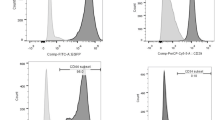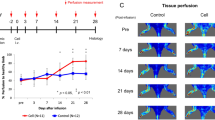Abstract
Critical limb ischemia (CLI) is a state of severe peripheral artery disease, with no effective treatment. Cell therapy has been investigated as a therapeutic tool for CLI, and pericytes are promising therapeutic candidates based on their angiogenic properties. We firstly generated highly proliferative and immunosuppressive pericyte-like cells from embryonic stem (ES) cells. In order to enhance the angiogenic potential, we transduced the basic fibroblast growth factor (bFGF) gene into the pericyte-like cells and found a significant enhancement of angiogenesis in a Matrigel plug assay. Furthermore, we evaluated the bFGF-expressing pericyte-like cells in the previously established chronic hindlimb ischemia model in which bone marrow–derived MSCs were not effective. As a result, bFGF-expressing pericyte-like cells significantly improved blood flow in both laser Doppler perfusion imaging (LDPI) and dynamic contrast-enhanced MRI (DCE-MRI). These findings suggest that bFGF-expressing pericyte-like cells differentiated from ES cells may be a therapeutic candidate for CLI.
Graphical Abstract









Similar content being viewed by others
Abbreviations
- CLI:
-
Critical limb ischemia
- ES cells:
-
Embryonic stem cells
- hES cells:
-
Human embryonic stem cells
- bFGF:
-
Basic fibroblast growth factor
- MSC’s:
-
Mesenchymal stem cells
- LDPI:
-
Laser Doppler perfusion imaging
- DCE-MRI:
-
Dynamic contrast-enhanced magnetic resonance imaging
- PAD:
-
Peripheral artery disease
- HLI:
-
Hindlimb ischemia
- Ang-1:
-
Angiopoietin-1
- SDF-1:
-
Stromal cell–derived factor-1
- PDGF-BB:
-
Platelet-derived growth factor isoform BB
- IL-8:
-
Interleukin-8
- HUVECs:
-
Human umbilical vein endothelial cells
- BMMSCs:
-
Bone marrow mesenchymal stem cells
- IHC:
-
Immunohistochemistry
- H&E:
-
Hematoxylin-eosin
- MAB:
-
Mesoangioblast
- FGF2:
-
Basic fibroblast growth factor
- ES-PLCs:
-
ES-derived pericyte-like cells
- VEGF:
-
Vascular endothelial growth factor
References
Uccioli L, Meloni M, Izzo V, Giurato L, Merolla S, Gandini R. Critical limb ischemia: current challenges and future prospects. Vasc Health Risk Manag. 2018;14:63–74. https://doi.org/10.2147/VHRM.S125065.
Armstrong EJ, Armstrong DG. Critical limb ischemia. Vasc Med. 2021;26(2):228–31. https://doi.org/10.1177/1358863X20987611.
Levin SR, Arinze N, Siracuse JJ. Lower extremity critical limb ischemia: a review of clinical features and management. Trends Cardiovasc Med. 2020;30(3):125–30. https://doi.org/10.1016/j.tcm.2019.04.002.
Teraa M, Conte MS, Moll FL, Verhaar MC. Critical limb ischemia: current trends and future directions. J Am Heart Assoc. 2016;5(2):e002938. https://doi.org/10.1161/JAHA.115.002938.
Mills JL Sr. Open bypass and endoluminal therapy: complementary techniques for revascularization in diabetic patients with critical limb ischaemia. Diabetes Metab Res Rev. 2008;24(Suppl 1):S34-39. https://doi.org/10.1002/dmrr.829.
Karimi A, Lauria AL, Aryavand B, Neville RF. Novel therapies for critical limb-threatening ischemia. Curr Cardiol Rep. 2022;24(5):513–7. https://doi.org/10.1007/s11886-022-01669-6.
Qadura M, Terenzi DC, Verma S, Al-Omran M, Hess DA. Concise review: cell therapy for critical limb ischemia: an integrated review of preclinical and clinical studies. Stem Cells. 2018;36(2):161–71. https://doi.org/10.1002/stem.2751.
Morishita R, Shimamura M, Takeya Y, Nakagami H, Chujo M, Ishihama T, et al. Combined analysis of clinical data on HGF gene therapy to treat critical limb ischemia in Japan. Curr Gene Ther. 2020;20(1):25–35. https://doi.org/10.2174/1566523220666200516171447.
Gu Y, Rampin A, Alvino VV, Spinetti G, Madeddu P. Cell therapy for critical limb ischemia: advantages, limitations, and new perspectives for treatment of patients with critical diabetic vasculopathy. Curr Diab Rep. 2021;21(3):11. https://doi.org/10.1007/s11892-021-01378-4.
Barc P, Antkiewicz M, Sliwa B, Fraczkowska K, Guzinski M, Dawiskiba T, et al. Double VEGF/HGF gene therapy in critical limb ischemia complicated by diabetes mellitus. J Cardiovasc Transl Res. 2021;14(3):409–15. https://doi.org/10.1007/s12265-020-10066-9.
Lozano Navarro LV, Chen X, Girata Viviescas LT, Ardila-Roa AK, Luna-Gonzalez ML, Sossa CL, et al. Mesenchymal stem cells for critical limb ischemia: their function, mechanism, and therapeutic potential. Stem Cell Res Ther. 2022;13(1):345. https://doi.org/10.1186/s13287-022-03043-3.
Shimatani K, Sato H, Saito A, Sasai M, Watanabe K, Mizukami K, et al. A novel model of chronic limb ischemia to therapeutically evaluate the angiogenic effects of drug candidates. Am J Physiol Heart Circ Physiol. 2021;320(3):H1124–35. https://doi.org/10.1152/ajpheart.00470.2020.
Armulik A, Abramsson A, Betsholtz C. Endothelial/pericyte interactions. Circ Res. 2005;97(6):512–23. https://doi.org/10.1161/01.RES.0000182903.16652.d7.
Hamilton NB, Attwell D, Hall CN. Pericyte-mediated regulation of capillary diameter: a component of neurovascular coupling in health and disease. Front. Neuroenerg. 2010;2:5. https://doi.org/10.3389/fnene.2010.00005.
Hammes HP, Lin J, Renner O, Shani M, Lundqvist A, Betsholtz C, et al. Pericytes and the pathogenesis of diabetic retinopathy. Diabetes. 2002;51(10):3107–12. https://doi.org/10.2337/diabetes.51.10.3107.
Beltramo E, Porta M. Pericyte loss in diabetic retinopathy: mechanisms and consequences. Curr Med Chem. 2013;20(26):3218–25. https://doi.org/10.2174/09298673113209990022.
Teichert M, Milde L, Holm A, Stanicek L, Gengenbacher N, Savant S, et al. Pericyte-expressed Tie2 controls angiogenesis and vessel maturation. Nat Commun. 2017;8:16106. https://doi.org/10.1038/ncomms16106.
Geranmayeh MH, Rahbarghazi R, Farhoudi M. Targeting pericytes for neurovascular regeneration. Cell Commun Signal. 2019;17(1):26. https://doi.org/10.1186/s12964-019-0340-8.
Eilken HM, Dieguez-Hurtado R, Schmidt I, Nakayama M, Jeong HW, Arf H, et al. Pericytes regulate VEGF-induced endothelial sprouting through VEGFR1. Nat Commun. 2017;8(1):1574. https://doi.org/10.1038/s41467-017-01738-3.
Roobrouck VD, Clavel C, Jacobs SA, Ulloa-Montoya F, Crippa S, Sohni A, et al. Differentiation potential of human postnatal mesenchymal stem cells, mesoangioblasts, and multipotent adult progenitor cells reflected in their transcriptome and partially influenced by the culture conditions. Stem Cells. 2011;29(5):871–82. https://doi.org/10.1002/stem.633.
Quattrocelli M, Palazzolo G, Perini I, Crippa S, Cassano M, Sampaolesi M. Mouse and human mesoangioblasts: isolation and characterization from adult skeletal muscles. Methods Mol Biol. 2012;798:65–76. https://doi.org/10.1007/978-1-61779-343-1_4.
Berry SE. Concise review: mesoangioblast and mesenchymal stem cell therapy for muscular dystrophy: progress, challenges, and future directions. Stem Cells Transl Med. 2015;4(1):91–8. https://doi.org/10.5966/sctm.2014-0060.
Scibona E, Morbidelli M. Expansion processes for cell-based therapies. Biotechnol Adv. 2019;37(8):107455. https://doi.org/10.1016/j.biotechadv.2019.107455.
Stebbins MJ, Gastfriend BD, Canfield SG, Lee MS, Richards D, Faubion MG, et al. Human pluripotent stem cell-derived brain pericyte-like cells induce blood-brain barrier properties. Sci Adv. 2019;5(3):eaau7375. https://doi.org/10.1126/sciadv.aau7375.
Dar A, Domev H, Ben-Yosef O, Tzukerman M, Zeevi-Levin N, Novak A, et al. Multipotent vasculogenic pericytes from human pluripotent stem cells promote recovery of murine ischemic limb. Circulation. 2012;125(1):87–99. https://doi.org/10.1161/CIRCULATIONAHA.111.048264.
Kumar A, D’Souza SS, Moskvin OV, Toh H, Wang B, Zhang J, et al. Specification and diversification of pericytes and smooth muscle cells from mesenchymoangioblasts. Cell Rep. 2017;19(9):1902–16. https://doi.org/10.1016/j.celrep.2017.05.019.
Sun J, Huang Y, Gong J, Wang J, Fan Y, Cai J, et al. Transplantation of hPSC-derived pericyte-like cells promotes functional recovery in ischemic stroke mice. Nat Commun. 2020;11(1):5196. https://doi.org/10.1038/s41467-020-19042-y.
Dar A, Itskovitz-Eldor J. Derivation of pericytes from human pluripotent stem cells. Methods Mol Biol. 2021;2235:119–25. https://doi.org/10.1007/978-1-0716-1056-5_8.
Vodyanik MA, Yu J, Zhang X, Tian S, Stewart R, Thomson JA, et al. A mesoderm-derived precursor for mesenchymal stem and endothelial cells. Cell Stem Cell. 2010;7(6):718–29. https://doi.org/10.1016/j.stem.2010.11.011.
Uenishi G, Theisen D, Lee JH, Kumar A, Raymond M, Vodyanik M, et al. Tenascin C promotes hematoendothelial development and T lymphoid commitment from human pluripotent stem cells in chemically defined conditions. Stem Cell Reports. 2014;3(6):1073–84. https://doi.org/10.1016/j.stemcr.2014.09.014.
Rotini A, Martinez-Sarra E, Duelen R, Costamagna D, Di Filippo ES, Giacomazzi G, et al. Aging affects the in vivo regenerative potential of human mesoangioblasts. Aging Cell. 2018;17(2):e12714. https://doi.org/10.1111/acel.12714.
Beyth S, Borovsky Z, Mevorach D, Liebergall M, Gazit Z, Aslan H, et al. Human mesenchymal stem cells alter antigen-presenting cell maturation and induce T-cell unresponsiveness. Blood. 2005;105(5):2214–9. https://doi.org/10.1182/blood-2004-07-2921.
Aggarwal S, Pittenger MF. Human mesenchymal stem cells modulate allogeneic immune cell responses. Blood. 2005;105(4):1815–22. https://doi.org/10.1182/blood-2004-04-1559.
Chen ST, Gysin R, Kapur S, Baylink DJ, Lau KH. Modifications of the fibroblast growth factor-2 gene led to a marked enhancement in secretion and stability of the recombinant fibroblast growth factor-2 protein. J Cell Biochem. 2007;100(6):1493–508. https://doi.org/10.1002/jcb.21136.
Evseenko D, Zhu Y, Schenke-Layland K, Kuo J, Latour B, Ge S, et al. Mapping the first stages of mesoderm commitment during differentiation of human embryonic stem cells. Proc Natl Acad Sci U S A. 2010;107(31):13742–7. https://doi.org/10.1073/pnas.1002077107.
Gao F, Chiu SM, Motan DA, Zhang Z, Chen L, Ji HL, et al. Mesenchymal stem cells and immunomodulation: current status and future prospects. Cell Death Dis. 2016;7:e2062. https://doi.org/10.1038/cddis.2015.327.
Hassanzadeh A, Rahman HS, Markov A, Endjun JJ, Zekiy AO, Chartrand MS, et al. Mesenchymal stem/stromal cell-derived exosomes in regenerative medicine and cancer; overview of development, challenges, and opportunities. Stem Cell Res Ther. 2021;12(1):297. https://doi.org/10.1186/s13287-021-02378-7.
Norgren L, Hiatt WR, Dormandy JA, Nehler MR, Harris KA, Fowkes FG, et al. Inter-Society Consensus for the Management of Peripheral Arterial Disease (TASC II). J Vasc Surg. 2007;45(Suppl S):S5-67. https://doi.org/10.1016/j.jvs.2006.12.037.
Singanamalli A, Rusu M, Sparks RE, Shih NN, Ziober A, Wang LP, et al. Identifying in vivo DCE MRI markers associated with microvessel architecture and gleason grades of prostate cancer. J Magn Reson Imaging. 2016;43(1):149–58. https://doi.org/10.1002/jmri.24975.
Pinker K, Helbich TH, Morris EA. The potential of multiparametric MRI of the breast. Br J Radiol. 2017;90(1069):20160715. https://doi.org/10.1259/bjr.20160715.
Xie Y, Su N, Yang J, Tan Q, Huang S, Jin M, et al. FGF/FGFR signaling in health and disease. Signal Transduct Target Ther. 2020;5(1):181. https://doi.org/10.1038/s41392-020-00222-7.
Davies MM, Mathur P, Carnochan P, Saini S, Allen-Mersh TG. Effect of manipulation of primary tumour vascularity on metastasis in an adenocarcinoma model. Br J Cancer. 2002;86(1):123–9. https://doi.org/10.1038/sj.bjc.6600020.
Tsunoda S, Nakamura T, Sakurai H, Saiki I. Fibroblast growth factor-2-induced host stroma reaction during initial tumor growth promotes progression of mouse melanoma via vascular endothelial growth factor A-dependent neovascularization. Cancer Sci. 2007;98(4):541–8. https://doi.org/10.1111/j.1349-7006.2007.00432.x.
Funding
This work was supported by Astellas Pharma Inc.
Author information
Authors and Affiliations
Corresponding author
Ethics declarations
Ethics Approval
All procedures performed in this study involving animals were approved by the Institutional Animal Care and Use Committee of Osaka University. No human studies were carried out by the authors for this article.
Conflict of Interest
K.S., H.S., K.M., and M.K. are employed by Astellas Pharma Inc.
Additional information
Communicated by Associate Editor Nicola Smart oversaw the review of this article.
Publisher's Note
Springer Nature remains neutral with regard to jurisdictional claims in published maps and institutional affiliations.
Supplementary Information
Below is the link to the electronic supplementary material.
Rights and permissions
Springer Nature or its licensor (e.g. a society or other partner) holds exclusive rights to this article under a publishing agreement with the author(s) or other rightsholder(s); author self-archiving of the accepted manuscript version of this article is solely governed by the terms of such publishing agreement and applicable law.
About this article
Cite this article
Shimatani, K., Sato, H., Mizukami, K. et al. Transplantation of Human Embryonic Stem Cell–Derived Pericyte-Like Cells Transduced with Basic Fibroblast Growth Factor Promotes Angiogenic Recovery in Mice with Severe Chronic Hindlimb Ischemia. J. of Cardiovasc. Trans. Res. (2024). https://doi.org/10.1007/s12265-024-10496-9
Received:
Accepted:
Published:
DOI: https://doi.org/10.1007/s12265-024-10496-9




